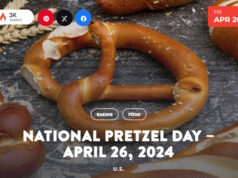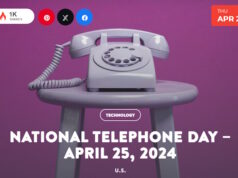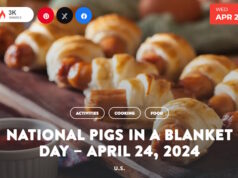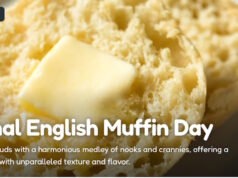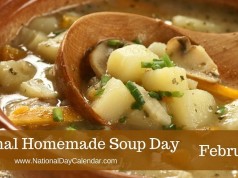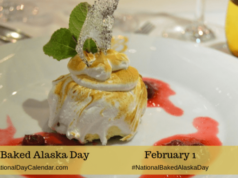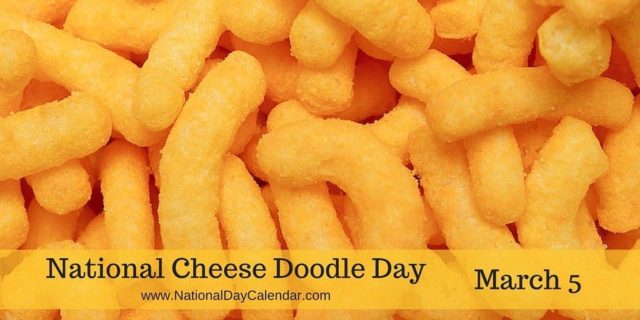
Updated April 7, 2024
(March 4, 2019) Are you ready for a great snack and orange fingers? Happy National Cheese Doodle Day! March 5th is the annual celebration for the cheddar cheese coated, puffed or crunchy, fried or baked snack food.
The actual inventor of Cheese Doodles is under debate.
- 1936 – The second most commonly cited inventor is Elmer Candy of New Orleans, Louisiana, around 1936. Today, Elmer’s Fine Foods still sells cheese doodles under the name ‘CheeWees’.
- 1939 – food historians will attribute the bite-size treat to one of two inventors; either one Edward Wilson and/or Clarence J. Schwebke, who worked at the Flakall Corporation in Wisconsin around the 1930s. This company actually specialized in making flaky pet food, but created what was called ‘Korn Kurls’ as a (for humans) snack and applied for a patent in 1939. The snack was commercialized in 1946 by another company, the Adams Corporation.
- 1948 – Generally, the credit goes to a man named Morrie Yohai who made a variety of extruded snack foods in the 1940s for his family’s company called Old London Foods.
- 1940s – The U.S. military helped invent Cheetos. Back in the WWII era, the military poured money into finding ways to dehydrate foods. Specifically, cheese. From the longer shelf life to the lighter weight, cheese powder was a smash hit — and also a key ingredient in Cheetos! In 1948 Frito‑Lay (then the Frito Company) introduced their first cheesy snack cracker, which contained the same Wisconsin cheddar that the army put in its dehydrated products. That cheese dust has some serious history!
- 1950s – Cheetos cheese-flavored puffs became a hit in the 1950’s soon, Cheez Doodles appeared.
- 1965 – The Cheez Doodle Company expands into other flavors, and the Borden Condensed Milk Company purchases it.
- 1970s – Chester Cheetah wasn’t always the mascot.Turns out the snack’s first spokescritter was a mouse! Seeing as mice love cheese, it seemed like a natural fit, and starting in the early 1970s, this character always took his favorite snack on all kinds of wild adventures. But a decade later, the motorcycle riding squeaker lost his edge, so the brand introduced Chester Cheetah. From his name to his swagger (and those shades!), this ultra cool cat seemed like a much better match for the brand.
- 1970s – A janitor invented Flamin’ Hot Cheetos. Well, make that a janitor turned exec! Richard Montañez worked as a janitor at the Frito-Lay factory in the 1970s, and after he started adding chili powder to his own Cheetos, he pitched the idea to the then-CEO. The CEO loved it, and the rest is history. Montañez is now an executive vice president at PepsiCo North America.
- 21st Century – National Cheese Doodle Day is celebrated by snack lovers, appreciating all the forms these cheesy creations come in.
- They come in a variety of shapes, sizes and flavors and 15 million pounds are produced annually.
- Cheese doodles are also known as cheese puffs, cheese curls, cheese balls, cheese poofs, cheesy poofs or sometimes corn cheese.
- “Cheez Doodles fingers” is the official word used to when you get cheese powder on your fingers after eating ANY cheese flavored snack food.
- Cheez Doodles are said to be one of the only packaged snack foods preferred by Julia Child.
- They have recently entered pop culture as the preferred snack of ESPN NBA analyst Stephen A. Smith, and are the favourite snack of Lincoln Peirce’s comic character Big Nate.
- Wise (the company that produces Cheez Doodles) recently made their Crunchy Cheez Doodles “cheezier,” more akin to Cheetos’ flavor.
- Cheetos are scientifically proven to be addictive. Once you tear into a bag, it’s hard to stop, and there’s a reason for it. According an Oxford study, the brain associates the crunching sound with freshness, so you might be convinced that what you’re eating is more appetizing than it really is. Oh, and then there’s this little thing called “vanishing caloric density,” which tricks your brain into believing that you’re not getting enough of the tasty snack.
- It takes 5,000 cows to generate a year’s supply of Cheetos.
- Despite any protestations, we love the neon orange cheese powder coating our fingers. (Blame science.) Turns out the professionals discovered why we love that orange dust so much. After bringing together a focus group, researchers watched their brain activity when they ate Cheetos. They discovered that we get a “giddy feeling of subversion“—embracing the rebelliousness of doing something we shouldn’t be doing—when we’re left with hands that make us look like Chester Cheetah. (Now we have Sweetos, which will coat our fingers in delicious cinnamon sugar goodness. About damn time, Cheetos.)
Sources:



